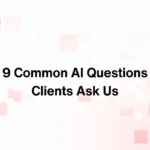
Integrating Artificial Intelligence (AI) technology in business practices has become a hot topic. Today, it’s nearly impossible to perform a Google search without coming across a statistic about AI and its profound impact on our work. These statistics, like how 83% of companies surveyed consider using AI in their strategy a high priority and how over 81% of employees believe that AI improves their overall performance at work–are not numbers we can ignore.
Innovative businesses and employees are embracing the AI movement and learning to use this new technology within their operations. However, there is more than one type of AI for your business. Choosing the right AI technology can be overwhelming, from off-the-shelf options to customized AI offerings. To help streamline the process, we have pulled together some techniques your business can follow to pick the best AI solution for your unique workflow.
These eight steps ensure that whatever AI platform you pick aligns with your business goals and requirements:
- Understand what AI can do for your business.
- Evaluate AI solutions.
- Assess data requirements.
- Consider fine-tuning vs. prompt engineering.
- Acknowledge the user experience.
- Align with future growth.
- Consider costs and returns.
- Implement a pilot program.
Why Use AI for Your Business?
Choosing an AI solution because a peer you know is using it or you have seen advertisements online for them is not the best way to pick your platform. Before considering the best AI technologies, start with your business.
Conduct an in-depth analysis of your business workflow and identify pain points and areas that could benefit from AI, such as:
- Workflow efficiency
- Decision-making
- Customer engagement
- Data analysis
- Marketing or advertising
- Inventory planning
While this is not an exhaustive list of everything you could find, identifying areas where your workflow might have blocks will help you create a more precise roadmap for the specific AI capabilities your business requires.
Evaluate AI Solutions
Once you have outlined how your business can benefit from AI, your next step is to evaluate the various AI solutions available in the market. Don’t fear the AI solutions, but consider each of them seriously and explore all the options, determining your potential solution’s features, functionalities, and scalability.
Will the AI solution you want to invest in seamlessly integrate with your existing infrastructure and not substantially disrupt the workflow? Is the potential AI software easy to use, implement, and train? In this step, consider your future AI software solution’s potential for customization and adaptability. Always think about how your AI technology can solve your problem right now and how it can cater to the evolving demands of your business.
Assess Data Requirements
Understanding the data requirements of the AI technology is crucial to ensure the efficient and effective functioning of the system. Don’t be fooled by AI systems offering all the bells and whistles and a low price tag. Some off-the-shelf solutions follow a pay-as-you-go model that can get pricy. For example, ChatGPT offers a cost per token to use their product. If you want to use this platform for prompt engineering or run extensive data sets through it, you might use more tokens than anticipated and quickly eat up your budget.
The takeaway here is to take your data usage seriously. Evaluate the volume, variety, and quality of data your business generates and accumulates. Consider your AI technology’s capability to handle and process this data, ensuring it can derive actionable insights and facilitate informed decision-making.
Consider Fine Tuning vs. Prompt Engineering
The learning capabilities of the AI technology you pick will play a pivotal role in its long-term viability and relevance. Not all AI platforms are the same, and you will need to determine if your business will benefit from an AI platform built through prompt engineering or fine-tuning.
Prompt Engineering: This is when the AI shapes its answers based on the responses provided by the user or engineer. The user will input a prompt, and the AI will use the prompt to take action and yield results.
Fine-Tuning (FT): This process involves adjusting a pre-trained model on specific tasks or datasets. An FT system can optimize an existing model’s performance and shape its behavior by applying new data sets to train its weights.
Which one is better AI for your business? It depends on your business goals and AI use case. Both prompt engineering and fine-tuning have their own pros and cons, but the technology platform you pick depends on the nature of your business requirements and your intended application of AI.
Acknowledge the User Experience
While the technical aspects of AI are crucial, the user experience is equally vital for successfully adopting and integrating AI technology. Prioritize AI solutions that offer:
- Intuitive interfaces
- Seamless interactions
- User-friendly functionalities
Choose an AI platform technology that can be easily integrated into your employees’ workflows and does not need extensive training. A positive user experience fosters a culture of acceptance and encourages widespread adoption of AI across various departments within your organization.
The same can be said if your AI solution is customer-facing. These AI solutions, such as the ever-popular chatbots and virtual assistants, should be designed to provide a smooth and intuitive experience for your customers, not another pain point to work through.
Align with Future Growth
Investing in AI technology is not just about addressing current business needs but also about preparing for future growth and scalability. Choose AI solutions that you can adapt to your business’s evolving dynamics. Look for technologies that offer:
- Scalability in processing power
- Data handling capabilities
- Integration with emerging technologies
A future-oriented AI technology will enable your business to stay ahead of competitors already using this technology and capitalize on new opportunities.
Consider Costs and Returns
While the potential benefits of executing AI technology within your business are great, don’t overlook the costs associated with its implementation and maintenance. As previously mentioned, pay-per-use platforms can be cost-prohibitive for some, so conduct a comprehensive cost-benefit analysis to determine the investment required to integrate AI technology into your business operations.
This analysis should cover the long-term return on investment, including increased efficiency, improved productivity, and enhanced decision-making capabilities. It should also cover the cost of choosing an off-the-shelf solution vs. a custom AI implementation. While an off-the-shelf AI solution might be cheaper initially, a custom solution might be a wiser long-term option concerning upgrades, scalability, security, and control over your AI datasets.
Strive to strike a balance between the initial costs and the potential returns, ensuring that the AI technology you choose offers a sustainable and profitable solution for your business in the long run.
Implement a Pilot Program
Before fully integrating AI technology into your business operations, consider implementing a pilot program to assess its functionality and performance in a controlled environment. Test the AI system’s capabilities on a small scale, monitoring its impact on your specific organizational processes or departments.
Gather feedback from the users and stakeholders involved in the pilot program to evaluate the effectiveness and suitability of the AI technology. Use any insights from the pilot program to make informed decisions regarding a broader implementation and rollout of the AI solution across your business.
This step is extremely important, as humans must always be in the loop. Your AI platform should never be left fully automated without human minds checking in and making sure everything is working as it should. When you implement a pilot program, you have the ability to see how the AI software runs within your organization and have the power to guide and shape it how you want it to be.
Seek Expert Guidance with Rōnin Consulting
Navigating the complex landscape of AI technology can be challenging, especially for businesses without prior experience. If choosing an AI solution is overwhelming, consider seeking guidance from AI experts and consultants. At Rōnin Consulting, our software developers and AI technologists can provide valuable insights and recommendations based on your business requirements.
When you work with Rōnin, you will collaborate with professionals with the experience to build and implement AI for your business. Rōnins expertise and guidance will help your business significantly streamline the process of selecting and integrating the right AI technology for your business.





